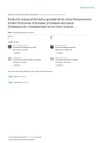Please use this identifier to cite or link to this item:
https://accedacris.ulpgc.es/handle/10553/73308
| Title: | Evolución temporal del índice gonadal de los erizos marinos Paracentrotus lividus (Echinoida: Echinidae) y Diadema africanum (Diadematoida: Diadematidae) en las islas Canarias (España) | Other Titles: | Temporal evolution of the gonad index of the sea urchins Paracentrotus lividus (Echinoida: Echinidae) and Diadema africanum (Diadematoida: Diadematidae) in the Canary Islands (Spain) | Authors: | González Henríquez, María Nieves Rey-Méndez, Manuel Gómez, José Luis Catoira de la Rosa, Manuel Ruiz Fernández, Gregorio Louzara Berard, Dominique Girard |
UNESCO Clasification: | 2401 Biología animal (zoología) 251005 Zoología marina |
Keywords: | Sea urchin Paracentrotus lividus Diadema africanum Gonadal Index Shellfish resource. |
Issue Date: | 2015 | Journal: | Revista de Biologia Tropical | Abstract: | There are three main species of regular sea urchins in the Canary Islands. To establish the optimal fishing seasons for two of them, we studied the evolution of the gonadal index in several years and locations, of Paracentrotus lividus (April 2006 to March 2008 on Tenerife island in two locations: Las Galletas and La Jaca and from April 2006 to January 2009 in Gran Canaria island in two locations: Ojos de Garza and Gando), and Diadema africanum (January 2010 to May 2011 on Gran Canaria island in three locations: Risco Verde, Arguineguin and Agaete). In the case of P. lividus, located on the southern edge of their distribution, the presence of several annual maximum gonadal indez peak was observed, probably related to the temperature. These times of gonadal index increases corresponded to the stages of maturation. The main period of maturity coincided with the fall and early winter (August, October and December). There was sporadic emissions of gametes depending on location, in April, during the summer (June, July or August), autumn (September or October) and winter (December, January or February). This fragmented situation is possibly due to exposure to the hydrodynamic area’s and food abundance. The maximum presence of D. africanum occurred in the months of May to June, with virtually no variations throughout the year, in the southernmost locality (Arguineguin). In conclusion, the two species of sea urchins would be complementary shellfish resources, as their periods of maximum GI (Gonadal Index, capture time) do not overlap during the year. Con el fin de establecer las épocas óptimas de explotación como posible recurso marisquero de dos especies de erizos de mar en Canarias, se estudió la evolución temporal del índice gonadal en diferentes años y localidades de Paracentrotus lividus (abril de 2006 a marzo de 2008 en la isla de Tenerife y en dos localidades: Las Galletas y La Jaca; abril de 2006 a enero de 2009 en la isla de Gran Canaria y en dos localidades: Ojos de Garza y Gando), y de Diadema africanum (de enero de 2010 a mayo de 2011 en la isla de Gran Canaria y en tres localidades: Risco Verde, Arguineguín y Agaete). En el caso de P. lividus, que se encuentra en el límite sur de su distribución, se constató la presencia de varios picos máximos anuales en el índice gonadal, probablemente relacionados con la temperatura. Estas épocas de mayor índice gonadal se correspondieron con los estados de maduración de las gónadas. La principal época de madurez coincidió con el otoño y comienzo del invierno (agosto, octubre y diciembre). Existió emisión de gametos esporádicos en el año según la localidad, en abril, en verano (junio, julio o agosto), otoño (septiembre u octubre) e invierno (diciembre, enero o febrero). Posiblemente esta situación tan dispar sea debido a la exposición al hidrodinamismo de la zona y a la presencia o no de abundante alimento. Para D. africanum se presentó el máximo índice en los meses de mayo-junio, con prácticamente pocas variaciones anuales en la localidad situada más al sur (Arguineguín). En conclusión, las dos especies de erizos serían complementarias como recursos marisqueros, ya que no se superponen sus periodos de máximos IG (época de captura) en el año. |
URI: | https://accedacris.ulpgc.es/handle/10553/73308 | ISSN: | 0034-7744 | DOI: | 10.15517/rbt.v63i2.23160 | Source: | Revista de Biologia Tropical [0034-7744], v. 63,suppl. 2, p. 251-260 |
| Appears in Collections: | Artículos |
Items in accedaCRIS are protected by copyright, with all rights reserved, unless otherwise indicated.
